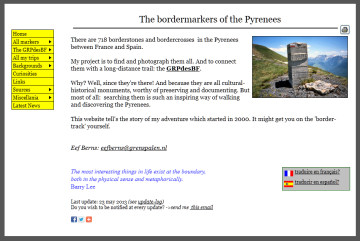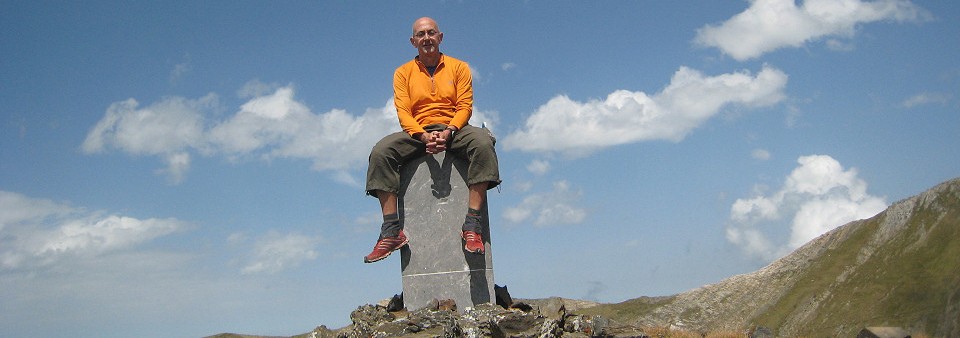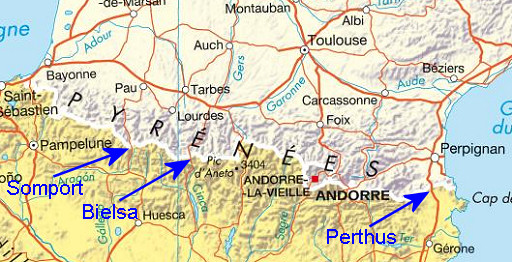 I’m proud to announce a new update with a new series of GRPdesBF-stages from bm410 to 427.
I’m proud to announce a new update with a new series of GRPdesBF-stages from bm410 to 427.
And there are many more additions: check the update-log.

 I’m proud to announce a new update with a new series of GRPdesBF-stages from bm410 to 427.
I’m proud to announce a new update with a new series of GRPdesBF-stages from bm410 to 427.
And there are many more additions: check the update-log.
Across the Pyrenees, there are a few cross-border tunnels:

– underneath Col de Somport there are two of them: the derelict train-tunnel (in use from 1928 to 1970) and – parallel of it – the modern tunnel of 2003
– underneath Col de Bielsa: the tunnel Aragnouet-Bielsa, opened in 1976
– underneath Col de Perthus: two railway-tubes for the high-speed line Perpignan-Barcelona, opened in 2010.
They all have bordermarkers at the borderline and typically at both sides of the tube. Let’s show what we got.
The somport-tunnel (the new one), these pictures were supplied by Charles Darrieu.
Interesting: the old railway-tunnel should also have bordermarkers, they might resemble the ones in the Bielsa-tunnel. The railway-tunnel is now in use as an emergency-tunnel for the new one.
The Bielsa-tunnel, these pictures were recently found by Jacques Koleck in the Archives of Dax. They are from Jean Sermet himself and are part of a file named “Démarcation frontalière des Hautes Pyrénées – Province de HUESCA” rédigé par Jean SERMET”from 1989 (archive-reference “Jean Sermet Archives Départementales des Hautes Pyrénées – cote F 398”). The installment of the plaques even involved a binational treaty. And see this account of Jean Sermet of the whole process. Charles Darrieu also has pictures of these markers (and the documents).
Finally, the Perthus-tunnel also has got his share of bordermarkers, two for each tube. Serge Poncet retrieved these pictures from the tunnel-company.
Cayetano (living in Girona, Spain) started in 2013 to search and photograph the esfr-bordermarkers between the province of Girona and France (bm427-602). Starting from the east, he has covered until now bm601 up to bm528. We can read that on his recently published spanish website www.mojonesdelospirineos.com
Cayetono refuses to use a gps-device to find the markers. He prefers maps, delimitation-proceedings and information/pictures from other sources. I can appreciate his approach, that’s how I started and found most of the bordermarkers.
I like his website a lot. Apart from the pictures of the bordermarkers he provides
– the original (delimitation-)treaties in Spanish (!)
– a dictionary of related terms
– some curiosities
– and he is – very modern – connected with Facebook, Twitter etcetera
One of my most remarkable finds was bm531 in the Eastern Pyrenees, found on april 19th 2007. We had just met near Hostal de la Muga a local (Jean Iglesias) who happened to know the bordermarkers surprisingly well in this area. He told something about an ‘escalier’ (stairway) to reach one of the bordermarkers. I didn’t understand it until I reached the spot where bm531 was supposed to be. I saw a ladder lying at the foot of large boulder and then made the connection. I used the ladder to climb to the top of the boulder where bm531 is engraved, being invisible from the ground.
Cayetano from Girona sent me this recent picture of the ladder. When comparing it to my pictures, it’s the same ladder. According to Cayetano, it’s still in sufficient shape to climb it. And on Alain Laridon’s website we can read how this ladder was constructed on the spot itself by Jean Iglesias.
But do you really need the ladder? It seems so if you look at the pictures but the answer is: NO.
On the right side of the boulder you can also climb easily and safely to the top, that’s what I’ve been told by Charles Darrieu and Jacques Koleck.
And about Cayetano: he’s the ‘new kid on the block’, living in Girona he wants to find each and every bordermarkers on the Girona-border with France (= bm427-602). More about his project and website later on.